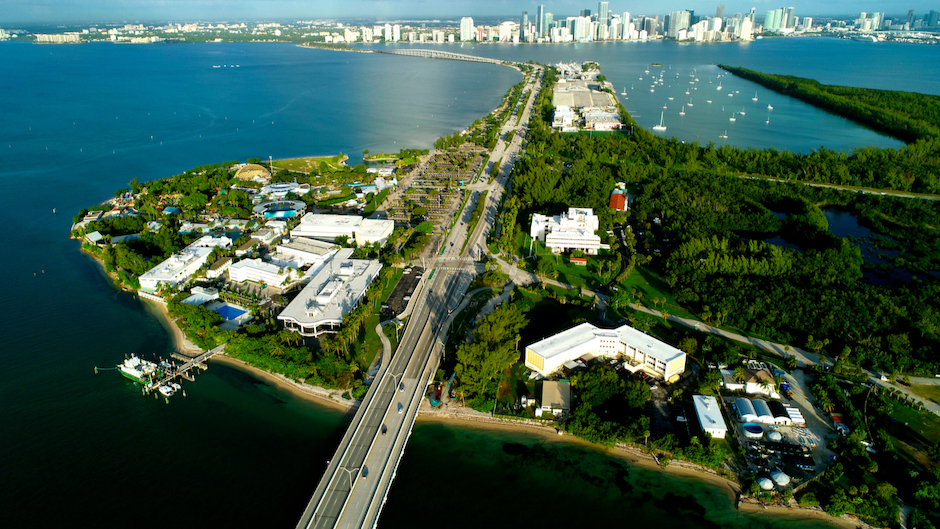With a record-setting hurricane season, rising sea levels, endangered coral reefs and diminishing fish stocks, climate research is vital to Florida’s future. Now, the University of Miami and the National Oceanic and Atmospheric Administration (NOAA) have launched the UM Cooperative Institute for Marine and Atmospheric Studies (CIMAS) – a $310 million, five-year research initiative aimed at addressing these global and regional challenges.
On November 17, UM President Julio Frenk, M.D., and Roni Avissar, dean of the Rosenstiel School welcomed attendees to the virtual launch of CIMAS, a collaborative academic partnership led by UM that includes Florida Atlantic University, Florida Institute of Technology, Florida International University, Florida State University, Nova Southeastern University, University of Florida, The Caribbean Regional Association Coastal Ocean Observing System, University of South Florida, and University of the Virgin Islands.
“CIMAS shows how government and non-government institutions can work together to enhance people’s lives,” said U.S. Rep. Debbie Wasserman Schultz, who serves on the House Energy and Water Subcommittee. “South Florida is ground zero for climate change, and this partnership is vital to our state’s future.”
As one of NOAA’s 16 cooperative institutes, CIMAS will bring together experts in many fields of science to study today’s critical climate problems. “Research plays a crucial role in addressing global and regional challenges,” said Frenk. “Since 1977, our university has partnered with NOAA and this new initiative provides an opportunity to generate scientific knowledge that will help us in planning and adapting to a changing climate.”
Avissar said the Rosenstiel School’s physical proximity to NOAA’s National Hurricane Center, Atlantic Oceanographic and Meteorological Laboratory and Southeast Fisheries Science Center is a tremendous asset in collaborative research. “Now, we have five years to make this partnership even more productive and we intend to do just that,” he said.
In partnership with NOAA and other agencies, CIMAS will conduct and coordinate innovative,
research with focus on the Southeast US., Gulf of Mexico, Caribbean and the South Atlantic, in four main areas:
• Tropical weather observations, analysis and prediction
• Ocean and climate observations, analysis and prediction
• Ecosystem observations, modeling, forecasting and management
• Protection and restoration of marine resources
"CIMAS brings together the resources of the University of Miami and NOAA to foster excellence in research and education targeted at understanding the Earth's oceans, atmosphere and marine ecosystems," said Ben Kirtman, director of CIMAS and professor of atmospheric sciences at the Rosenstiel School. "This collaboration enables unprecedented innovation in NOAA's mission of science, service and stewardship."
Jeffrey Duerk, provost and executive vice president for academic affairs, said improving hurricane intensity forecasts is one example of the collaborative research initiative. “We have the ability to bring in machine learning and use multiple modeling techniques to assess data from ocean and atmospheric observations,” he said, adding that UM’s Institute for Data Science and Computing (IDSC) has one of the nation’s top five academic computing capabilities. “CIMAS also allows us to demonstrate our commitment to addressing societal problems.”
Analyzing tropical weather observations and developing predictive models is one aspect of CIMAS’ research mission, said Emily Becker, associate director. Another is studying ocean and climate data to improve climate variability models and build regional adaption strategies. “We are also developing a CIMAS undergraduate internship program, building a diverse and inclusive talent pipeline for the future,” she added.
CIMAS will support marine ecosystem modeling, forecasting and management, including aquaculture practices to feed the world, said David Die, associate director. “We are also looking at the sustainability of marine resources, such as coral reefs, mangroves and seagrasses.”
Clay Porch, director of the NOAA Southeast Fisheries Science Center, said CIMAS researchers contribute to every aspect of the center’s field and laboratory research. “Our 350 employees work seamlessly with CIMAS faculty members and students,” he added. “This partnership provides us with a great talent pipeline for natural resources scientists.”
Calling CIMAS a “phenomenal partnership, John Cortinas, director of NOAA’s Atlantic Oceanographic and Meteorological Laboratory, said, “We could not accomplish what we have done for the American public without this research collaboration, which brings together a diverse set of experts. We look forward to a very productive future.”

